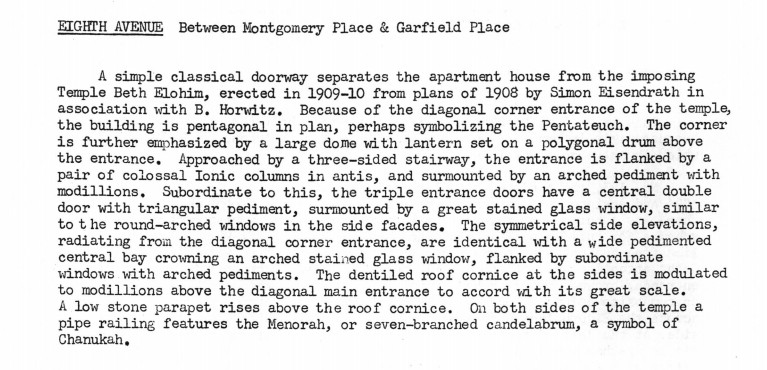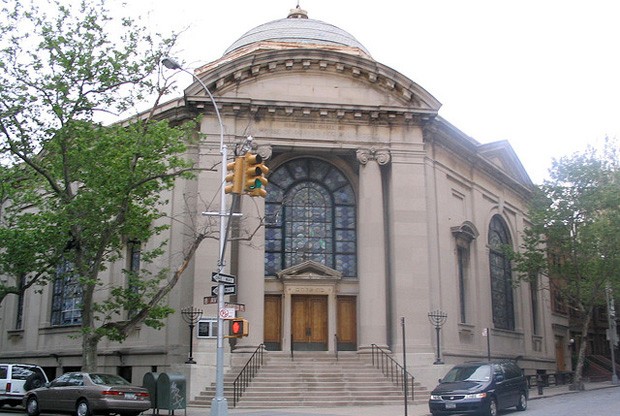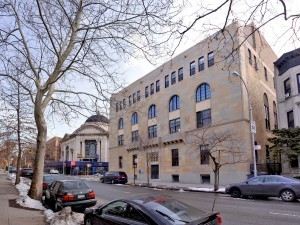Congregation Beth Elohim and Temple House
Introduction
Text-to-speech Audio
Images
Description of Congregation Beth Elohim building in the 1973 New York City Landmark Preservation Committee Designation Report. Taken from http://s-media.nyc.gov/agencies/lpc/lp/0709.pdf. Accessed on 10/28/2015

Exterior of the Congregation Beth Elohim Taken from http://www.tabletmag.com/scroll/100367/beth-elohim-wins-250k-preservation-grant. Accessed on 10/28/2015

View of Temple House and CBE from west side of Eighth Avenue. Taken from http://adparchitects.com/prtfolio/congregation-beth-elohim/. Accessed on 10/28/2015

Backstory and Context
Text-to-speech Audio
The Congregation Beth Elohim (CBE) was founded in 1861 as a breakaway of Brooklyn’s first Jewish Congregation, the Congregation Baith Israel. This was a move by forty-one German Jewish congregants eager to implement more liberal modes of worship in line with their Central European roots. In their first permanent home on Pearl Street in Brooklyn Heights, the CBE implemented mixed gender worship and led services in both German and Hebrew. In keeping with their liberal tendencies, the CBE hired a young and innovative rabbi, Rabbi William Sparger, who introduced even more radical changes to the services. The congregation grew so dramatically and so quickly that it had to move to a larger worship space just down the road at the intersection of State and Hoyt.
The final decades of the nineteenth century saw few changes in the congregation despite an influx of Eastern European Jewish immigrants during “The Great Migration.” Congruent with their liberal policies, the CBE sought to Americanize their practices and integrate more seamlessly into a largely Christian, non-immigrant community, which meant resisting the influence of both Eastern European Orthodoxy and growing Zionist movements. The Rabbi George Taubenhaus even created an English language newspaper for the group as a means of presenting the CBE as a truly American, rather than immigrant, congregation.
The CBE remained consistent in its progressive policies during the early twentieth century. In 1902, the first American-born rabbi, Rabbi Alexander Lyons, took over leadership of CBE. In addition to being the first American to preside over the CBE, Rabbi Lyons was also the first to be formally trained at the Hebrew Union College, which would become a central institution in American Reform Judaism. Indeed, in 1911, under the leadership of Lyons, the CBE officially joined the Reform Union of American Hebrew Congregations.
The 1929 stock market crash and ensuing global depression proved a trying time for the CBE. The congregation was still deeply in debt from the 1909 construction of their Classic Revival* style Eighth Avenue Temple, and the pre-Crash, 1929 ground-breaking on the adjacent Art Deco** style Temple House placed them on the verge of bankruptcy. However, despite decreased membership and battles with the bank, they sought to develop community programming, even opening an Academy of Adult Jewish Education.
Indeed, the social turbulence of the time provided a new mission for the congregation. Rabbi Lyons, in response to the rise of fascism and Nazi racist rhetoric, began championing interfaith and interracial alliances in the community. After the devastation of World War II and the Holocaust, the congregation followed the reformist movement in supporting Zionism and the creation of a Jewish state in Israel.
The "white flight" to the suburbs that characterized the 1960s precipitated a decline in membership that persisted into the early 1970s. The CBE hoped that the creation of a nursery school in combination with the Park Slope community’s Brownstone Revival project would help to attract Jewish families back to the neighborhood. The creation of the Park Slope Historic District (a New York City Landmark District) in 1973 and the 1980 addition of the CBE buildings to the National Register of Historic Places did help to revitalize the congregation.
Over the past three decades, the CBE has experienced continued growth, even being named one of the twenty-five most vibrant Jewish congregations in America by Newsweek in 2009. It continues to be a cultural center not just of the Jewish community of Park Slope, but for a larger group of Brooklynites, frequently hosting book releases, concerts, and other neighborhood events. It was even the recipient of a 2012 Preservation Grant from American Express and the National Trust, voted on by New York community members. The congregation has allocated those funds to help restore the building and repair a stained glass window.* The Classical Revival design can be found in the formal, symmetrical construction. It is especially evident in the columnns flanking the front entrance.
** The Art Deco features can be found in the very angular design of the building and the bas-relief work around the windows.
Sources
"Historic District." Park Slope Civic Council. Accessed Web, 6/9/17. http://parkslopeciviccouncil.org/historic-district/.
"Park Slope Historic District Designation Report." NYC. Accessed Web 6/9/17. http://s-media.nyc.gov/agencies/lpc/lp/0709.pdf.
"America's 25 Vibrant Congregations." Newsweek. 4/5/09. Accessed Web, 6/9/17. http://www.newsweek.com/americas-25-most-vibrant-congregations-77069.
"Brownstone Revival Coalition Home Page." Brown Stone Revival. Accessed Web, 6/9/17. http://www.brownstonerevival.org/Home_Page.html.
Abelow, Samuel Philip. History of Brooklyn Jewry. Brooklyn, New York. Scheba Publishing Company, 1937.
